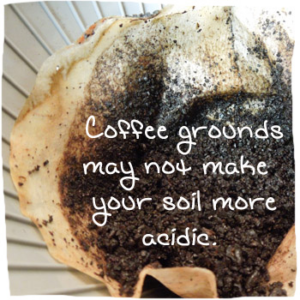 Let’s talk coffee grounds as a natural fertilizer for vegetables and other plants.
Let’s talk coffee grounds as a natural fertilizer for vegetables and other plants.
A study from Linda Chalker-Scott entitled “Coffee Grounds-Will They Perk Up Plants?” shows some evidence that grounds might enhance beets, cabbage and spinach but could potentially damage tomatoes. But how?
Grounds will add a bit of nitrogen. We gotta have that! But do you know when to apply nitrogen to fertilize cabbage, broccoli, carrots and kohlrabi? If you add it too late in the growth cycle you could do more harm than good. Apply nitrogen before, fruits, flowers, heads or the edible part starts to form. Nitrogen will make lots of leaves but it will not promote fruit development. That is why so many people have problems with their tomatoes. They use a soil amended with too much nitrogen. Those commercial brands with timed-release nitrogen encourage the plant to focus on leaf development.
Coffee grounds may not change the acidity of the soil enough to benefit acid loving plants. You would have to dump lots of it in the same spot over several months and maybe even years to make a difference. Once brewed, most of the acid leaches out of the bean and into your cup.

If you like adding coffee grounds to the soil as an amendment or a source of nitrogen, mix them up into the soil to avoid a hard crust on the surface. In my own garden, I combine them with crushed eggshells, kelp and compost to maximize nutrient content.
Coffee grounds are not rated as a commercial fertilizer with lab verified percentages by weight of nitrogen, phosphorus and potassium. If they were, it would look something like this:
Nitrogen: 2% percent
Phosphorus: .05% percent
Potassium: .06% percent
Used as a soil amendment, there could be beneficial amounts of magnesium and copper in addition to the primary nutrients listed above. Added to your compost pile, coffee grounds would be considered a green or nitrogen-rich ingredient. You would want to balance those out with the same or a bit more brown and carbon-rich materials such as dried leaves, paper and cardboard.
I also use coffee grounds near my cool weather crops that are beginning to develop into young plants – no heads or bulbs yet. Houseplants that do not flower are also another good candidate for your used coffee grounds. Try to work them into the soil just a bit or water down significantly, and as always, use in moderation.


